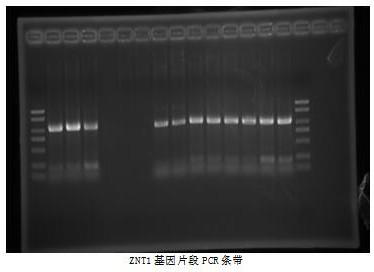Transgenic plant plasmid p3301-121-ZnT1 for repairing polluted water bodies and application thereof
A technology of transgenic plants and plasmids, applied in the field of bioremediation of pollution, can solve the problems of long plant growth cycle, high living environment requirements, and small biomass.
- Summary
- Abstract
- Description
- Claims
- Application Information
AI Technical Summary
Problems solved by technology
Method used
Image
Examples
Embodiment 1
[0074] Establishment of plant tissue culture system
[0075] Take wild water peanut plants, wash them with clean water for 10 minutes, and cut off the shorter stems with germs and the shorter stems with axillary buds. Sterilize with 75% ethanol for 1 min and 1% NaClO for 8 min on a sterile operating table, wash the sterilized stems with sterile water 6-7 times, remove residual water on sterile filter paper, and then place them on the callus Tissue induction medium (MS+2mg / L2,4D+1mg / L6BA+20mg / L sucrose) and shoot induction medium (1 / 2 MS+2mg / L6BA+0.1mg / LNAA +30mg / L sucrose) culture medium , until it grows into callus and subculture seedlings (such as Figure 12-13 ). The stem segment with axillary buds was asexually propagated in a sterile environment as the original material for tissue culture.
Embodiment 2
[0077] Construct targeting vector and transform into plants:
[0078] (1) Construction of the target carrier:
[0079] Retrieve the ZNT1 gene sequence (AF133267.1) in Genebank, entrust Nanjing Yidao Biotechnology Co., Ltd. to chemically synthesize the ZnT1 target gene fragment, and make the ZNT1 gene (the applicant retrieved the ZNT1 cds sequence on GenBank, and chemically synthesize the ZNT1 target gene by the biological company) fragment, and then amplified by PCR), digested with restriction endonucleases SmaI and XbaI, connected to the plasmid expression vector p3301-121 after double digestion with the same enzymes, and named p3301 -121-Znt1 plasmid (for its structure see figure 1 ), into Agrobacterium strain EHA105 by electroporation;
[0080] (2) Agrobacterium leaf disk transformation method to transfer the target gene
[0081] Receptor material selection: Cut the leaves of the sterile plants cultivated in experiment (4) into small pieces of 1cm×1cm, cut the stem lengt...
Embodiment 3
[0086] Resistance of transgenic plants to heavy metals zinc and cadmium
[0087] Reserve Zn ion solutions of 25mg / L, 75mg / L, 125mg / L, and 175mg / L, and take 5 parallel samples. Use atomic absorption spectrophotometry to detect Cd in the sample, take 5 parallel samples of transgenic plants and sterile seedling plants under the Cd concentrations of 0 mg / L, 20 mg / L, and 40 mg / L to measure, and calculate the standard for the results. difference and take the mean value, and measure the Cd in the root of the plant, the heavy metal content in the stem and leaf is as attached Figure 4 - attached Figure 7 As shown, it can be seen from the figure that with the planting of transgenic plants, the concentration of Zn and Cd in the solution decreased significantly, while the concentration of heavy metals in the plant also increased significantly with the growth of time. When the heavy metal concentration in the medium was 175 mg / L, the adsorption capacity of transgenic plants could reach...
PUM
| Property | Measurement | Unit |
|---|---|---|
| adsorption capacity | aaaaa | aaaaa |
Abstract
Description
Claims
Application Information
 Login to View More
Login to View More - R&D
- Intellectual Property
- Life Sciences
- Materials
- Tech Scout
- Unparalleled Data Quality
- Higher Quality Content
- 60% Fewer Hallucinations
Browse by: Latest US Patents, China's latest patents, Technical Efficacy Thesaurus, Application Domain, Technology Topic, Popular Technical Reports.
© 2025 PatSnap. All rights reserved.Legal|Privacy policy|Modern Slavery Act Transparency Statement|Sitemap|About US| Contact US: help@patsnap.com



